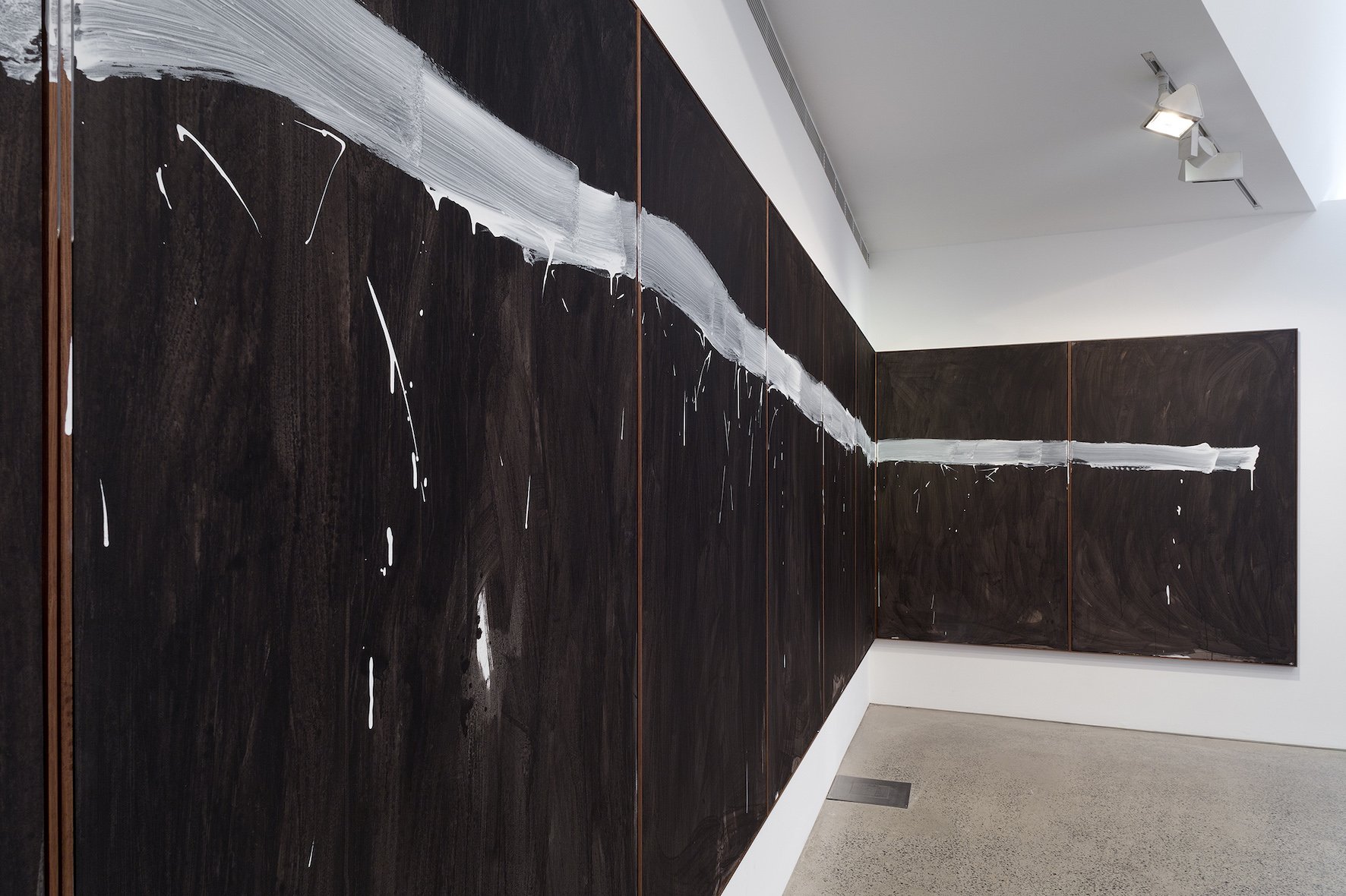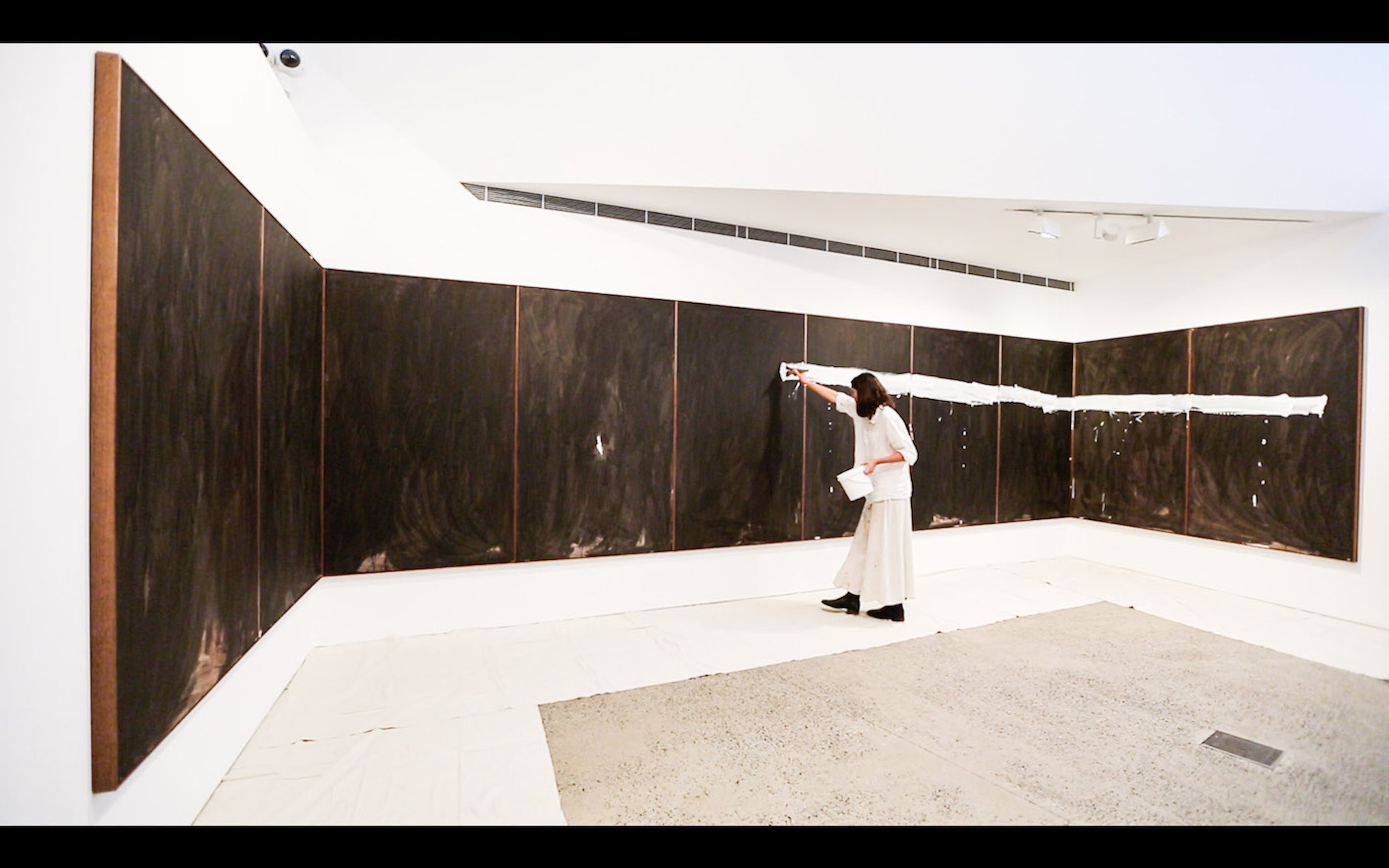
Ages and Ages 2018, 180x1100cm, acrylic on board

Ages and Ages , The Hug, 2018

Ages and Ages 2018, 180x1100cm, acrylic on board

Ages and Ages, private performance, 2018
In The Remembering
Heide Museum, Melbourne 2018
Essay by Brooke Babbington, Curator, Heide MOMA
In this exhibition, Newcastle-based artist Lottie Consalvo has painted a continuous white line across the surface of ten large painted panels custom-fit to wrap around half the perimeter of Heide’s Project Gallery. Her use of familiar painterly cues—bold contrasts, an improvisational composition and dynamic sense of movement—initially lead us to read the work as traditional painting, yet the gestural line is a conspicuous later addition, painted in situ. It runs uninterrupted across supports and over frames, signalling beyond its painted surface and disrupting any such easy reading.
Ages and Ages, 2018, is in fact the result of a private performance in which the artist positioned herself alone in the gallery and ‘psychologically within a particular memory’. The residual mark is a visual record of a moment of deep contemplation, documenting the body in a state of emotional transition.
In the sweep of this arc of paintings stands a larger-than-human-scale plaster sculpture that suggests in its bulk and proportions, embodied matter. In the company of Ages and Ages, The Hug, 2018, emphasises the noticeable absence of the artist, whose hand is otherwise so present in the space, doubling as a proxy for the artist-as-performer. The latest in Consalvo’s series of sculptural works exploring the gesture of the hug, it has been formed from plaster embraced while wet—the negative space standing in for its recollection and its loss. In the context of this work, the painted line of Ages and Ages now appears to encircle the gallery in a painterly ‘embrace’; each artwork fully realised only in its relationship to the other.
Remembering is by its nature often a solo activity, and for Consalvo, artmaking is an equally personal endeavour. Consalvo believes in the intimacy of an artist working in private or in the studio, reflecting that it can be ‘just as—if not more—resonant than live performance’. Her works are intimate in their conception, too. Consalvo describes the catalyst for this new series of sculptures as a dream or visitation she experienced of the embrace of a loved one. ‘In this way’, Consalvo explains, the work grapples with ‘a memory of something that never even happened in a physical sense’. This disclosure adds an additional layer of meaning which elaborates on the ideas of absence and loss.
By contrast, the particular recollection mined in the creation of Ages and Ages is not revealed. In this instance preferring to foreground an archetypal rather than specific experience of memory, Consalvo is careful to give the audience some distance to allow the work’s associative potential to unfold. This, and the artist’s sense that the deeply personal quality of reminiscence carries with it some vulnerability, means that the question of disclosure in Consalvo’s work is finely balanced and often the scaffold on which the work’s meaning hangs.
Both Ages and Ages and The Hug refer to past creative acts suspended perpetually in the present. This emphasises what French conceptual artist Daniel Buren has described as the ‘great beauty of a work’, as that which ‘lies without doubt in the fact that all the interactions that have brought it about remain visible in the finished piece ... Every work is in reality the result of a sometimes substantial number of interactions. Of interferences’. Within this poetic register, the work opens a gap between the doing of the act (the hug, the performance) and the being of the object (the sculpture or painting)—occupying a space somewhere between artist-object and object-viewer. Both evolving out of performative acts comprising an intense physical and psychological communion with remembrance, Ages and Ages and The Hug might more fittingly be described as choreographic forms.
Taken as a whole, In the Remembering invites meditation on the shifting and ultimately ungraspable nature of memory. The works are studies on the structure of recollection, rendering it in tangible and visible form. Consalvo’s protracted line in Ages and Ages, for instance, implies an elongated sense of time that is in keeping with the way mental recall itself distorts history, while devices of framing and display deliberate on memory’s archival quality. Similarly, the casting process, of which The Hug makes rudimentary use, engages with ideas of lack, loss and repetition that are also characteristic features of remembrance. Tensions between absence and presence, and the coincidence of present and past are at play in the works, as are the artist’s efforts to negotiate a space in which the two might co-exist.
This installation reconciles and advances a number of Consalvo’s creative concerns—in particular, her interest in creating between or beyond the limitations of her media. Consalvo’s use of performance to ‘think through’ painting or sculpture in the current context relates to earlier works, such as her mid-fall series from 2016. This series engaged with the motif of ‘the fall’ across performance and painting in artworks that considered the ‘possibilities for transformation that lie within a moment … moments of eternity, transition, points of no return—these moments of between and becoming’. While Consalvo’s practice more recently has been grounded in painting, previously it was punctuated by a number of endurance performances which could be considered antecedents to the present installation; carried out in everyday life, they existed for an audience only as documentation. From August 2013, Consalvo enacted a yearlong performance in which she lived with minimal possessions (Compartmentalise, 2013–14). In another, she devoted a year to living out her desires in an attempt to find lasting happiness (Desires, 2014–16). In all of her previous work, Consalvo has dealt with longing, loss, desire, moments of reverence and the sublime, frames of mind she often measures autobiographically against her own life experiences.
The concepts in Consalvo’s artwork often carry over between mediums—leading the artist to reflect that there is ‘a lot of thinking’ in her painting practice. This, Consalvo suggests, is what distances her work from the lineage of action painting. For her, any painting could be considered performative (just as, for Buren, every work bears the marks of its making), whereas Ages and Ages records a psychological shift, not simply the artist in the act of painting. It examines the performing-body as the threshold of an invisible movement between interior emotional and outward physical states and seeks to suspend this movement in physical matter, tracing its psychological path through physical space. Separating her work further from traditional painting is its condition that once performed, it cannot be edited; a fact that imparts, paradoxically, both a boldness and vulnerability not often seen in painting.
In the Remembering in fact merges three distinct strains of Consalvo’s practice—painting, performance and sculpture—and represents the first time the artist has combined these approaches. In both The Hug and Ages and Ages, the transient quality of performance acts as a counterweight to the permanence and tangibility of the resulting forms, foregrounding the tension between the two. The approach further speaks to the structure of memory as simultaneously enduring and ephemeral.
Biography
Lottie Consalvo was born in 1985 in Sale, Victoria and is now based in Newcastle, New South Wales. She graduated with a Bachelor of Business Entrepreneurship from RMIT University, Melbourne in 2006 and completed short courses in Gold and Silversmithing at Monash University, Melbourne in 2007 and Engineering (Fabrication and Welding) at Victoria University, Melbourne in 2009. Selected solo exhibitions include in silence, Dominik Mersch Gallery, Sydney, 2017; Momentary Alters, NKN Gallery, Melbourne; mid-fall, Alaska Projects, Sydney, both 2016; and Everything Reminds Me of You, Damien Minton Gallery, Sydney, 2014. Selected group exhibitions include Into Abstraction II, Macquarie University Gallery, Sydney, 2017; New Strokes, Gallery9, Sydney, 2016; Vivi Con Aqua, Millerntor Gallery#5, Hamburg, 2015; Mono No Aware, Linden Gallery, Melbourne (curated by SuperKaleidoscope), 2013; Traces, Leipzig Art Fair, Germany, 2012. In 2015, Consalvo was invited to participate in the Marina Abramović artists’ residency program, part of Marina Abramović: In Residence presented by Kaldor Public Art Projects, Project #30. She has also undertaken residencies in Leipzig, Germany in 2011; and in Nairobi, Kenya and Titjikala Art Centre Northern Territory in 2012.
by Brooke Babbington, Curator Heide MOMA